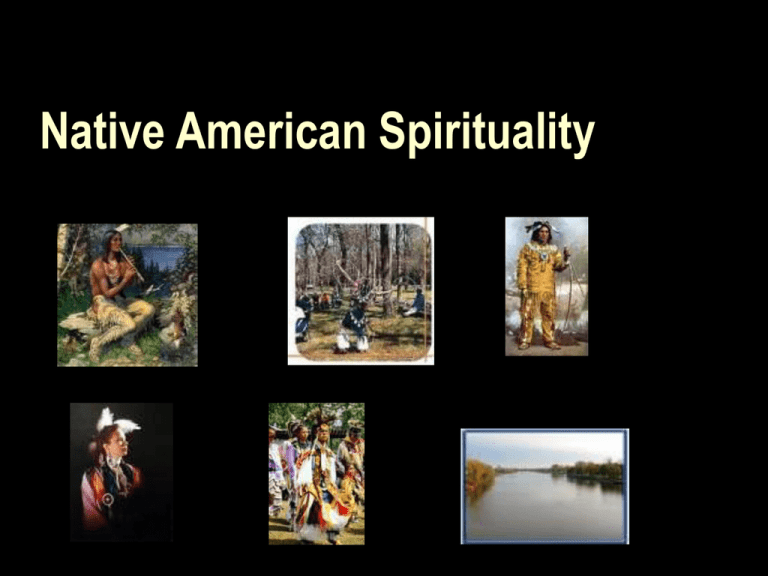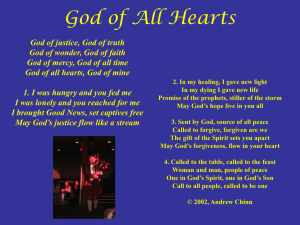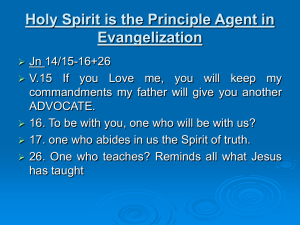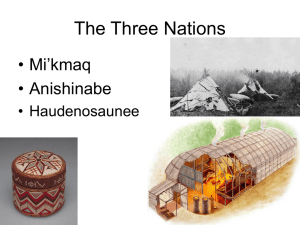
Native American Spirituality
Anishinabe – Ojibwa: “The Original People”
In North America there are many
different groups of native persons.
This presentation will focus on the
spirituality of the Anishinabe, pronounced
“a-ni-shi-nah-bay,”or Ojibwa people.
Anishinabe means “Original People”
They are a prominent native group in
Ontario.
Kitche Manitou
The Ojibwa people believe in a great animating force that
pervaded all existence.
They called this force Kitche Manitou, which means “Great
Spirit.”
The Ojibwa believe that Kitche Manitou created four basic
elements from which all other substances were made: rock,
water, fire and wind.
Kitche Manitou breathed life into them and each had its own
power and spirit.
These four spirits created the physical universe: sun, moon,
stars and earth.
Ojibwa believe that Kitche Manitou created all of the plants,
which have have spiritual and healing powers. Kitche Manitou
also created the animals and gave them special powers.
Finally Kitche Manitou created humans as beings dependent
upon the powers of nature. However, the Ojibwa believe that
humans received the greatest gift – the power to dream.
Turtle Island
Native Americans call North America Turtle Island.
The Ojibwa tell the story of how Kitche Manitou flooded the
earth because its creatures had forgotten to love, honour and
respect all beings in the circle of life. There was no land for
the surviving creatures to live on, but through the pity of the
Great Spirit, the creatures repented. Makinaak, the turtle
offered his back to be the foundation of the new land. Other
animals would swim to the bottom of the water and bring up
mud to put on Mankinaak’s back. Once a small island was
formed, the animals swam in a circle which caused the land
to grow. Then plants, grasses and trees began to grow on
the land and the animals began to inhabit the land.
Eventually, Kitche Manitou brought human beings,
Anishinabe, the original ones, to play on the earth, but they
also forgot the original teachings as their animal brothers did.
Again the Great Spirit was going to destroy the earth with fire.
The white eagle having pity for the foolishness of the humans
appealed to Kitche Manitou to spare them. The eagle asked
“If I am able to find one person who remembers the original
teachings of loving, honouring and respecting all creatures in
the circle of life, will you spare the destruction for one more
day?” Kitche Manitou agreed and so each day the eagle flies
out at dawn to see if at least one human remembers. When
he finds one, he brings the news to Kitche Manitou and the
earth is spared for one more day.
The Eagle: The Prayer Carrier
The graceful bird of the skies, the eagle, is the prayer
carrier and messenger of the Anishinabe people. As
the eagle soars above the skies, one knows he is
carrying the prayers to the Creator.
The eagle has great significance for the Anishinabe
people when it comes to healing ceremonies and
ceremonies honouring and respecting other people.
As a person begins to grow more spiritual, he learns to
respect and honour the graceful eagle of the skies. An
individual might see himself as the eagle when he
prays for the people who are in need of prayer
In the healing ceremonies performed by the medicine
man or woman, the eagle carries the sickness out of
the body and up to the Creator for healing. The person
who sick must believe in the power of the prayer
carrier.
The Medicine Wheel
The Medicine Wheel is the foundation for Anishinabe
teachings about walking on the earth in a good way.
The term “medicine” does not refer to drugs or remedies.
The Medicine Wheel and its teachings assist individuals along
the path toward mental, spiritual, emotional and physical
enlightenment.
The Medicine Wheel is a representation of how all things in
the natural world come in fours: four directions, four seasons,
four stages of life, four basic elements.
Anishinabe believe in a creation which has as its centre, the
symbol of a sacred circle. The Medicine Wheel circle
represents a harmonious relationship with nature and with all
living things who are relatives.
Anishinabe believe that all creatures are connected and equal
because like the circle there is no beginning and no end.
An Anishinabe wise man said: “Birds make their nests in
circles; we dance in circles; the circle stands for the Sun and
Moon and all round things in the natural world. The circle is
endless creation, with endless connections to the present, all
that went before and all that will come in the future.”
The Medicine Wheel cont’d
The Medicine Wheel cont’d
NORTH Earth - Wisdom
As we get older our hair turns white, as we come to our time of winter.
White (and purple) also symbolize spirituality. With experience and age
we gain wisdom. Now there is time to rest and contemplate the lessons
learned from the spirits and from the elders. North is purity and
wisdom, a great place of healing.
North is the place of winter which reminds a person to stop and listen
and to prepare for the long time of winter.
The animals of the North are the Moose and Bear. Each is prepared and
has a layer of fat to sustain them through the winter. They are also the
primary source of meat during the winter time for people. They rest and
take things slow, not wasting energy, and with the understanding of
what winter brings.
The Medicine Wheel cont’d
SOUTH - Fire - Passion
Growth in the South it is the time of Summer.
South is the time of mid-day, the hottest part of the day, the part when the sun is
overhead and no shadows are cast.
A person matures from childhood into being an adult in the direction of the South.
It is the time to accept change, to learn and to understand.
Red is for fire, passion, and a time of fertility. The South is the place of passion in all
things, sex, fertility, mating - the fires that burn within.
The Medicine Wheel cont’d
WEST Water – Emotions
This is the stage of later adulthood, the time of Fall, the time of the setting
sun - twilight. The daylight fades and brings a new awareness in this time
of gradual change.
The time of the West is when a person learns responsibility for others and
for all things.
It is the time to prepare, to finish things for the time of Winter is coming.
As the place of emotions it is the place of family, of love and of
responsibility
The Beaver demonstrates the team work and preparedness needed for the
coming winter. The snake reminds us to shed our skin to grow and change.
The Medicine Wheel cont’d
EAST - Air - Flight
Beginnings start in the East, from where the sun rises to begin a new dawn. Each
day is a good new day with a new start.
East is the direction of the physical body and of newness, including
newborn children.
East is the time of change for all is a new beginning. New ideas and seeing the light.
Spring is the season when all things begin to grow and awaken.
Yellow is the path of Life, to begin the walk as a warrior.
The sun rising in the east empowers each person. The energy to do and to begin the
action of the mind and heart is there.
Animals with wings and flight include: the hummingbird, the owl, and the hawk.
Words are given to the east that the smoke in the air or the voices in the air may be
carried to Spirit.
Symbolism of Animals
Anishinabe beliefs are animistic which is demonstrated by their belief in the powers of the nonhuman beings in nature.
Turtle represents mother earth sustaining creation with constancy and generosity. Turtle emerged
from the water with earth on its back, providing a living place for human beings and all creatures
between sky and water. Turtle is the medium of communication, the emissary of beings of this world
and time and beings of another world and dimension of time. Turtle symbolizes thought given and
thought received and represents clarity of communication between beings
Crane represents eloquence of leadership and direction. The voice of the Crane is unique and
infrequent. When Crane speaks, all listen. Crane is the spokesperson for the clans.
Eagle received from Kitche Manitou the gifts of strong wings, keen sight and proud bearing. Eagle
symbolizes courage and preknowledge. His sphere is the mountains and the heights.
Rabbit represents Wanabozho, a messenger of Kitche Manitou, an intermediary on earth among
different species of beings; rabbit is an advocate for the Anishinabe, to whom he imparted the gift of
knowledge.
Deer received from Kitche Manitou the gift of grace. Deer symbolize love.
Bear received from Kitche Manitou the gift of courage and strength. Bear is representative of all
medicine powers in creation. Claws dig medicine roots. Bear passes on knowledge through dreams
and visions.
Ojibwa Totemism
The Ojibwa Clan System was created to provide
leadership and to care for food, shelter, protection,
medicine, education and leadership.
There were seven original clans and each clan was
known by its animal emblem, or totem.
The animal totem symbolized the strength and duties
of the clan.
The Crane and the Loon Clans were given the power
of Chieftainship. By working together, these two clans
gave the people a balanced government with each
serving as a check on the other.
The people of the Fish Clan were the teachers and
scholars. They helped children develop skills and
healthy spirits.
The Bear Clan members were the strong and steady
police and legal guardians. Bear Clan members spent
a lot of time patrolling the land surrounding the village,
and in so doing, they learned which roots, bark, and
plants could be used for medicines to treat the ailments
of their people.
Ojibwa Totemism cont’d
The people of the Hoof Clan were gentle, like the deer
and moose or caribou for whom the clan is named. They
cared for others by making sure the community had
proper housing and recreation. The Hoof Clan people
were the poets and pacifists, avoiding all harsh words.
The people of the Martin Clan were hunters, food gathers
and warriors of the Ojibwa. Long ago, warriors fought to
defend their village or hunting territory. They became
known as master strategists in planning the defense of
their people.
The Bird Clan represented the spiritual leaders of the
people and gave the nation its vision of well-being and its
highest development of the spirit. The people of the Bird
Clan were said to possess the characteristics of the
eagle, the head of their clan, in that they pursued the
highest elevations of the mind just as the eagle pursues
the highest elevations of the sky.
For the Ojibwa, the honouring of animal totem helps
them to love and to commune with Mother Earth and with
Kitche Manitou better.
The Philosophy of the Seven Sacred Teachings
These Seven Teachings Of Inspiration exist to maintain the sacredness of life,
and to ensure survival as living beings on this Earth. They are reminders that all
beings are one - we are all connected - regardless of racial, cultural, religious,
socio-economic, or political background..
Love
Courage
Wisdom
Truth
Respect
Honesty
Humility
The Philosophy of the Seven Sacred Teachings
The eagle is a symbol of love
The First Peoples of Turtle Island (North America) were to
always carry out actions in love. To feel true love is to know
the Creator. A person’s first love is to the Great Spirit. For the
Ojibwa, a person expresses love for the Great Spirit by loving
himself/herself. Only then can a person truly love others.
Children are to be loved, for children are gifts from the Great
Spirit.
The bear is a symbol of courage
To have courage is to have the mental and moral strength to
listen to the heart. It takes courage to do what is morally right.
First Nations people were told to be proud of who they are
and never to deny the way of life the Great Spirit gave to
them.
The Philosophy of the Seven Sacred Teachings
The beaver is a symbol of wisdom
To live in wisdom is to know that the Great Spirit gave
everyone special gifts. Wisdom is shown by building a
peaceful and healthy family and community. Wisdom is an
instrument of the Great Spirit, helping to bring peace to the
world.
The turtle is a symbol of truth.
Always seek the truth. The truth lies in spirit.
Prayer was to be done every day at sunrise to give thanks to
the Great Spirit for the gift of life. Each of the gifts and
ceremonies were given by the Great Spirit to the Original
human beings to help them find the truth and the true
meaning of their life on Earth.
The Philosophy of the Seven Sacred Teachings
The buffalo is a symbol of respect.
First Nations people were told to always respect all life on
Mother Earth. To show real respect is to share and give of
yourself for the benefit of all life. Respect the Elders from all
races of people who uphold the sacred teachings of the Great
Spirit.
The sabe or sasquatch is a symbol of honesty.
To be honest with yourself is to live in the spirit of how you
were created. Never lie or gossip about each other. The more
honest you are the bigger you become as a person.
The Philosophy of the Seven Sacred Teachings
The wolf is a symbol of humility
Always carry out actions in humility. Think of family, fellow
human beings community before you think of yourself.
Humility is knowing and understanding that you are not more
or less important than anyone else. Being humble is
surrendering to the Great Spirit, who has created and who
directs all life.
The Pow Wow
Pow wow is derived from the Algonguian word "pau wau". It means, "He dreams".
The pow wow is a living cultural expression of song, dance, and art which brings
people together, and through the drum, reminds Anishinabe of their connection to
Mother Earth.
The pow wow is used to preserve the culture and heritage of the Anishinabe
people.
Singing and dancing are the highlight of the pow wow.
Dances include Round Dances or Circle Dances, performed in a circle by facing
the center of the pow wow arena.
The Grass dance is one of the oldest dances and is still used in pow wow.
Religious in nature, it evolved from warrior society dances. It portrays a warrior in
search of a proper ceremonial place. The dancer moves in imitation of tall swaying
prairie grass.
Dreams or visions were the basis of the Jingle Dress dance. The dress for this
dance is fashioned with such items as small hawk bells, shells, or sewing thimbles
to give it sound. The dance was originally used as medicine. Movements have
undergone several transitions, and today's dancers twist their feet in unison to the
right and left while moving sideways.
Pow Wow Images
The Anishinabe Drum
Without the drum there would be no Pow wow. It is the center of the
Pow wow celebration that can be used to heal and unify all people. The
drum represents the circle of life.
The Pow wow drum is a large drum, approximately one metre in
diameter. A drum is made of wood and hide, both natural materials.
These materials represent honesty and sharing.
The wood comes from a tree. The tree gives life so that the drum can
be built. The tree is also telling us where life comes from. Without the
sun and the earth there would be no trees - no life. The Anishinabe, the
people, were lowered to this earth by the hand of the creator. The tree
grows up toward the creator, the source of its life and all of the life on
this earth. The hide is from an animal who gives its life for the drum and
in this way, represents the gift of sharing.
Once a drum has been made, it is usually given to an individual or a
group. Certain people are given the responsibility or instructions in the
making of the drum. It is never created as a craft or a toy. Before the
drum can be sounded at a Pow wow it must be blessed through a
special ceremony led by a elder or a group of elders. Once the
ceremony has been completed the drum may be sounded at any Pow
wow.
There are usually four or more singers around the drum. A person is
usually given the responsibility of caring for the drum. He is called the
drum keeper or the drum carrier.
The drumbeat is described as the heartbeat of the people. The drum
itself is regarded as a sacred object to be treated with respect. Each
drum has a keeper to ensure that no one approaches it under the
influence of alcohol or drugs, or shows disrespect by reaching across or
setting things on it.
The Smudge Ritual
In the time of spirit, ceremony and belief, the Great Spirit gave to Turtle
Island's Original People four sacred plants: sweetgrass, cedar, sage and
tobacco.
These medicines were meant to be used in prayer and for other peaceful
purposes. When combined the smoke carried our prayers to Great Mystery.
Today, what is often called a 'Sweetgrass Ceremony' opens many
gatherings, powwows, meetings, conferences anywhere people are gathered
together in a good way.
The word 'smudge' is a bit of a slang term when describing the four plants
as a group; 'smudging' means the action of fanning or pushing the smoke
over you.
The Smudge Ritual
SWEETGRASS - literally is sweet grass and often grows in
dark, marshy places. It is braided to signify unity and
strength. A single blade of grass can be broken, but
when braided it cannot be broken. It soothes the
emotions, calms the nerves, brings down the heart rate.
Its perfume drops your shoulders and you move into the
rhythm of the Earth.
CEDAR - the sweet smell and healing properties are used
in physical healing. Bathing in a cedar bath or the
occasional cup of cedar tea helps to cleans the internal
and external body. Feel its power seep into your pores.
Feel the pulse of your heart as your body embraces its
own health and well-being.
The Smudge Ritual
SAGE - The power of spiritual healing - as the sage wafts across
your body, breathe it into your soul. Let your spirit find its
balance with the emotions and the physical body. Feel its
power raise your spirits, feel yourself stand taller and stronger.
There are holes in the spirit when it is sad, the sage fill those
holes with good thoughts and positive attitudes.
TOBACCO - The most powerful of all because it gives thanks to
the Great Spirit and to the Ancestors. Often considered to be the
oldest plant on Turtle Island, it was never meant to be smoked
for commercial purposes! Tobacco is given to Elders or
Traditional Teachers when requesting assistance or information.
Tobacco is sprinkled in thanks to the Earth Mother, to the Great
Spirit and to the Ancestors for gracing us with their presence.
Tobacco should be held in the left hand, closest to the heart.
Raise your hand, it should be offered to the four directions
before being scattered.
HOW TO SMUDGE: Place cedar, sage, sweetgrass into a clay
bowl. Light it carefully and let the smoke start to rise. Rub your
hands in the smoke, scoop the smoke into your hands and bring
it to your body - head, heart, solar plexus. Listen carefully, for
the Ancestors have come along with the spirit of the
plants. They are here to help you heal. As is the way with all
things sacred, great respect must be given to the process of
smudging for a relationship is being formed between you, the
plant spirits and the Ancestors. It is powerful and must be
respected.
The Sacred Fire
For most tribes, fire symbolizes the heart of the
people.
It is present as all ceremonies.
Fire cleanses and renews the spirit. It symbolizes a
rebirth of being.
The smoke from the fire is used to send prayers to
Kitche Manitou.
Fire is used to cleanse sacred items before they are
used in a ceremony.
The Pipe
The pipe is used for spiritual healing.
Not everyone has a pipe. It has to be earned.
A pipe is normally received after years of learning under the
following circumstances: (a) A legitimate Elder or Traditional
Teacher who is a pipe carrier and who has earned the right to
give pipes and who does or does not know you, yet has had
at least four profound experiences about you (dreams,
visions). (b) the pipe was inherited through the family and the
current owner has "earned" the right to smoke it.
Generally Sacred Pipes consist of two parts: a tobacco
holding bowl made of bone, wood, stone, or metal and a
stem, usually made of wood.
The pipe is held in the left hand because it is closer to the
heart.
Tobacco is used because its smoke rises high toward the
Great Spirit and it represents both the sacred and profane
realms.
Once the tobacco is lit, the smoke is drawn down the stem of
the pipe, but it is not inhaled. For a moment the smoke
merges with the person’s breath and creates the unity of the
sacred and profane realms.
The smoke is released and prayers are sent toward Kitche
Manitou.
27
The pipe is passed in a clockwise direction because it
represents the direction of the sun.
The Vision Quest
A vision quest is a rite of passage or initiation.
Vision quest preparations involve a time of fasting and
the guidance of a tribal Medicine Man.
This quest is undertaken for the first time in the early
teenage years.
The quest itself is usually a journey alone into the
wilderness seeking personal growth and spiritual
guidance from the Spirit.
Traditionally, seekers find a place that they feel is
special. They sit in a 10 foot circle and bring nothing in
from society with the exception of water.
A normal Vision Quest usually lasts two to four days
within this circle, in which time the seeker is forced to
look into his soul.
It is said that a strong urge to leave the Quest area will
come to the seeker and a feeling of insanity may set in.
However, the seeker normally overcomes this by
reminding him or herself of the overall outcome of the
quest, which causes the mind to stop wandering on
random thoughts. The individual can generally find
solace in the fact that he or she will not die in just two to
four days.
The Vision Quest
Some have claimed grand visions on their first Vision Quest while
others have not. It is an individual experience and often subject to the
emotional, spiritual, and physical make-up of the person.
Native American totems are said to be capable of speaking through all
things, including messages or instructions in the form of an animal or
bird.
Generally a physical representation of the vision or message such as a
feather, fur or a rock is collected and placed in the seeker's medicine
bag to ensure the power of the vision will stay with the individual to
remind, protect or guide him.
Since the beginning of this cycle of time, humanity has returned to
nature to connect with spirit and to seek answers to problems of the
physical realms, especially in this timeline when the messages of
prophecy reveal themselves to the seeker.
There is something about being alone in the wilderness that brings a
person closer and more aware of the 4 elements and our connection to
a creational source. We go to seek truths and divine realization, just as
many of the ancient prophets did in their time.
In its own way - the vision quest is an Initiation not unlike the days of
the ancient mystery school teachings where one learns about
themselves and the mysteries of the universe are often revealed to
them. It is a time of internal transformation and renewal. Who am I?
Why am I here?
In a vision quest, conditions are set up that allow the soul to move
beyond the illusions of the little self and enter the unity of the inner
whole. It is a time of fasting - praying - and being in nature.
The Vision Quest
It is a period of solitude in which we seek an inner
revelation - a vision -which grants profound meaning and
direction to our life.
This initiation leads to maturity and an understanding of
our responsibility to ourselves, our society, our natural
environment, and our soul.
In Native American traditions these times of inner trial
are marked liked passages. Time is set aside to honour
them.
It might take a day, a week, a month - whatever is
necessary to complete the transformation and get the
answer one seeks.
Today, there are companies which sponsor vision
quests. They provide a wilderness area in which it is to
occur, and they give instructions and guidance before
and after the event.
The Sweat Lodge
With the help of Medicine Men and Women the sweat lodge is an
opportunity to repair the damage done to the spirits of men and
women.
It is a place of refuge and of healing but it is also a place to get
answers and guidance by asking: spiritual entities, totem helpers, the
Creator and Mother Earth.
The ceremony of the sweat lodge begins with the Fire Keeper
preparing a fire to heat up the stones called “Grandfathers.”
The participants prepare by smudging themselves and by offering
tobacco to the fire.
The sweat lodge is also smudged and prayers are offered asking that
the sweat lodge be used in a good way.
The fire stones are carefully brought into the sweat lodge at four
different times to signify the calling of the spirits from the four different
directions.
The stones are placed in the pit that symbolizes Kitche Manitou.
Medicine water (water and cedar, sage or sweetgrass) is splashed on
the red hot rocks.
The ancestors are summoned in prayer and the participants share the
wisdom of the original teachings.
The healing ritual usually takes three to four hours and is followed by a
feast.
The Dream Catcher
The dream catcher is based on the legend of how the trickster spirit in
the guise of a spider, spoke to the spirit leader.
During the conversation the spider spoke about the four stages of life
and how there were good and bad forces in the universe.
The spider spun a web within the spirit leader’s willow hoop.
When the spider was finished he had created a web in a perfect circle
with a hole in the centre.
The spider gave the web to the spirit leader and he told him to use it to
help his people reach their dreams, if they followed the teachings of
Kitche Manitou.
The web will catch the good thoughts in their dreams while the bad
thoughts will go through the hole in the centre.
The spirit leader taught his people to make dream catchers, so that
they would lose their evil ideas.
The people believe that the dream catcher holds the destiny of their
dreams.










